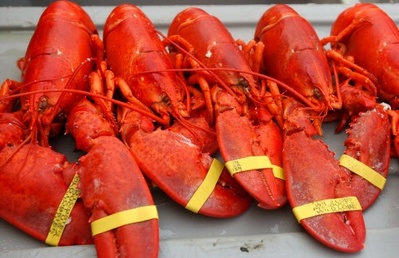Low prices and a market glut may be the biggest problems many Maine lobstermen had to deal with this year, but there are other looming challenges facing the industry, and they have more to do with the marine environment than money.
According to University of Maine marine biologist, Robert Steneck, the depletion of cod and the effects of global warming — along with existing economic challenges — are combining to test the ingenuity of lobstermen, even as the Gulf of Maine undergoes dramatic changes.
But the problem isn’t too few lobsters; there are more than enough.
That abundance is a relatively new development, said Steneck, a professor in the School of Marine Sciences at the University of Maine’s Darling Marine Center in Walpole, during a presentation to academics, fisheries representatives and governmental officials at a lobster symposium in Portland Wednesday. The event, “The American Lobster in a Changing Ecosystem,” runs through Friday.
The surge in the Gulf of Maine lobster population has been a boon to Maine, which now enjoys a “lucrative monoculture” in fisheries, with lobsters accounting for 85 percent of the value of harvested marine resources, Steneck said. The fishery, he said, “is better today than ever before.”
Lobstermen expected this year’s catch to compare favorably with last year’s record catch of 100 million pounds, which was worth $330 million at last year’s wholesale prices.
But with the population increase comes potential trouble. In environments of low biodiversity — the current state in the Gulf of Maine — disease and the effects of global warming can be disastrous because they can strike virtually the whole ecosystem, often swiftly and ferociously.
Even now, a synchronicity of conditions — abundant populations, an increase of 2 to 4 degrees in ocean temperatures and a resultant migration of different fish species northward into the Gulf of Maine — could create an ecosystem that makes lobsters more vulnerable to disease and stressed by new predators, Steneck said.
“Dynamic food webs and dynamic climate are colliding,” he warned. Any one — or more — of these influences suggests “how on the edge this fishery is,” said Steneck.
Lobstering historically has been Maine’s most valuable commercial fishery, according to the state Department of Marine Resources. The once-diverse marine environment in the Gulf of Maine in the mid-19th century led to a decline in lobster numbers for a time, but by the late 1990s the same waters had been transformed into a haven for the present-day “lobster monoculture,” Steneck said.
The gulf had evolved from a marine system “dominated by large predatory fish,” primarily cod, into one in which such species were almost completely absent.
“Big fish are ecologically extinct,” Steneck said.
The world below the surface of the Gulf of Maine “is now (one of) abundant small fish. It is an ecosystem that has fundamentally changed,” with “an unbelievably high density of lobster.”
Last summer, a shell disease, caused by bacteria that invade through pores in the outermost layer of the shell, ravaged the lobster fishery in Rhode Island, said Steneck, and that experience “should be a wake-up call” for all Atlantic coastal fisheries.
The disease causes a range of problems in affected lobsters, from unsightly black spots on the outer layer of the shell to fusing of the shell to inner membranes, making it impossible for the crustacean to molt.
Some preliminary studies suggest lobsters may be contracting the disease from chemical compounds that are by-products of industrial sources such as detergents, paints and plastics.
“We have to expect the unexpected,” Steneck said. “We have to fish smarter.”
“We have to have the ability to make changes,” said Patrick Keliher, commissioner of the Department of Marine Resources. Management of the fisheries “must be adaptive,” ready to respond to unanticipated economic developments or changes in the ecosystem.
The main issue now is profitability of the resource — lobstermen say they struggled this year to turn a profit despite abundant catches because the wholesale price was too low to pay for equipment and fuel prices.
“There is a desire in the industry to do something, (but) change is a difficult thing,” Keliher said.
The department expects to begin conversations with various constituencies in late December or January to see what kinds of steps might be taken to improve conditions for lobstermen and the fisheries.
Organizing at a local level and grassroots participation will be essential to accomplish the kinds of changes that are needed, Steneck said.
“We need to be fishing more economically,” he said. “We need to reduce how expensive fishing is and lower those costs.”
The expense of fuel, boat costs, traps and maintenance poses daunting economic odds to lobstermen, and “right now the crisis is economic,” said Steneck.
“The longer term problem is that we have to find ways to diversify our ecosystem.”
Whatever choices are made, Steneck said, the state has to find ways to “reinvent fishing on the coast of Maine to make it sustainable in the future.”
North Cairn can be contacted at 791-6325 or at:
ncairn@pressherald.com
Send questions/comments to the editors.



Comments are no longer available on this story